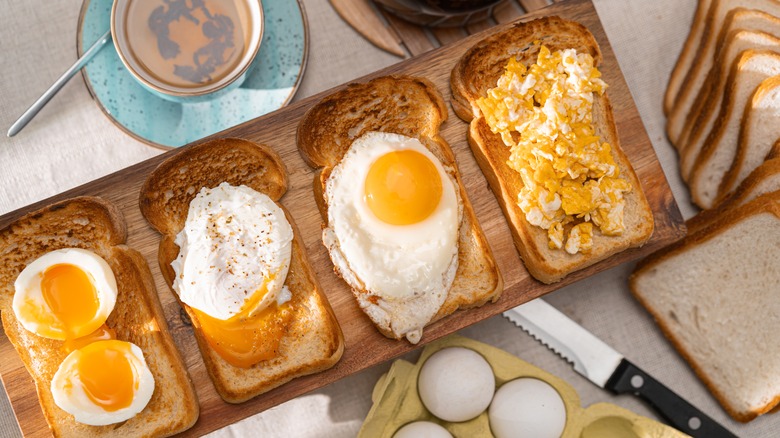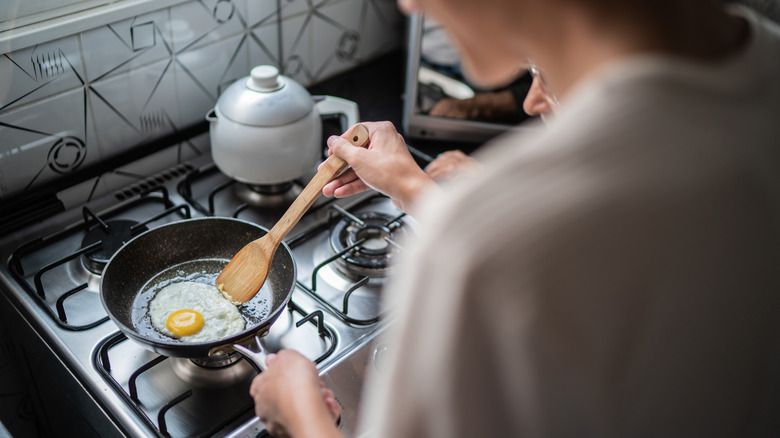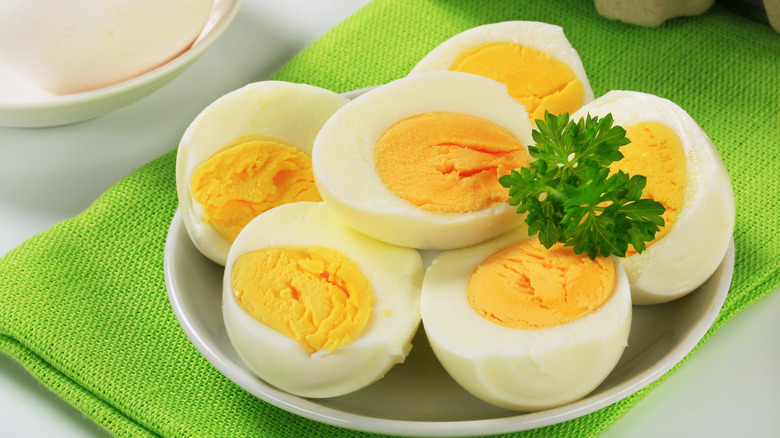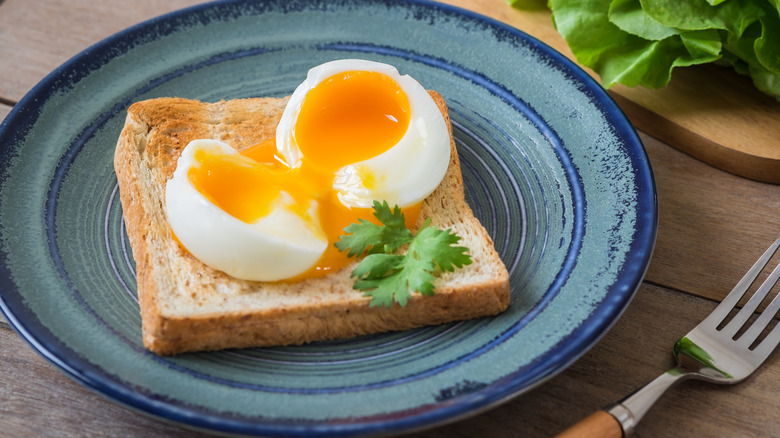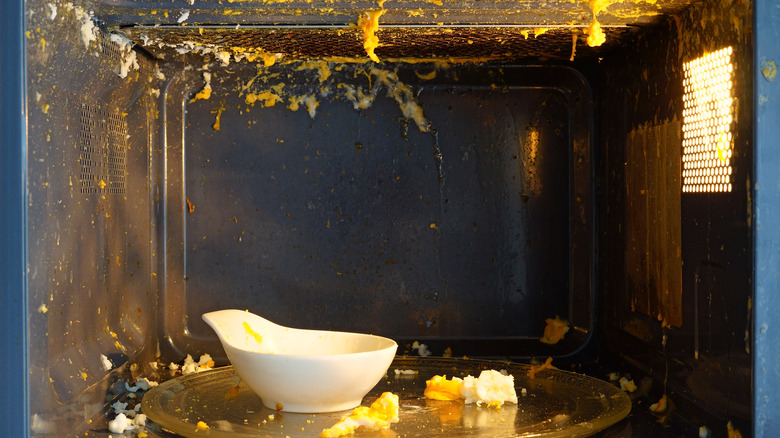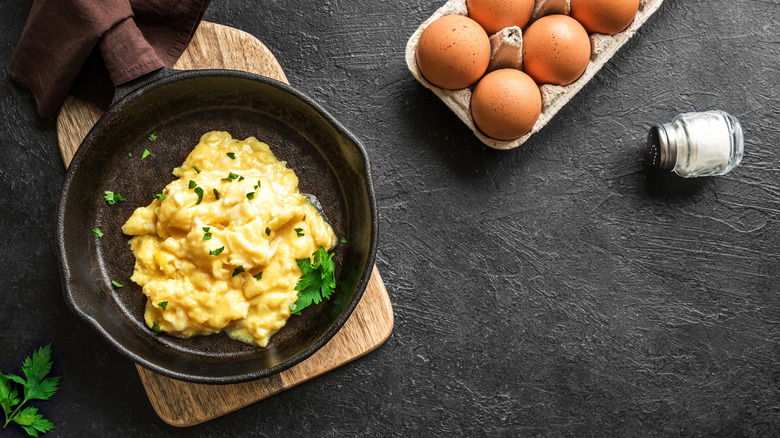The 7 Unhealthiest Ways To Cook Eggs
When it comes to healthy eating, there are some foods that come to mind instantly — things like fresh fruits and veggies (smoothie, anyone?), whole grains, and, of course, eggs. According to Healthline, these small, self-encased superfoods come loaded with health benefits. Eggs are chock full of vital nutrients, including vitamins, minerals, antioxidants, and amino acids vital for overall health. On top of that, they're cheap, versatile, and incredibly easy to prepare on their own or as part of your favorite recipe. That being said, you'll want to pay attention to how your eggs are cooked, as the method used can actually have a dramatic effect on their nutritional value — for better or for worse.
There are a surprising number of factors to take into consideration when trying to get the most bang for your buck from a carton of eggs. While undercooking your eggs can expose you and those you're serving to foodborne illness and bacteria, overcooking comes with just as many issues. It's true that cooking can make certain nutrients found in eggs more digestible, but conversely, the high heat used in some cooking methods can damage or even destroy the nutritional benefits you're trying to reap. So just what cooking methods constitute the unhealthiest ways to prepare this nourishing little superfood?
1. Frying
It likely isn't very surprising to find frying on a list of the unhealthiest ways to cook eggs. After all, frying by definition involves cooking something at a high heat in some kind of fat — usually oil or butter. And while fried eggs are undeniably delicious (and really, is there such a thing as an unappetizing fried food?), it certainly isn't the best way to maximize an egg's nutritional value. For instance, one study published in the International Journal of Food Sciences and Nutrition found that while eggs offer an excellent source of vitamin A, high-heat cooking reduces the amount of the vitamin found in eggs by up to 20%.
And with frying, we also have to consider the health consequences of the type of oil or fat used. Studies, like one published in the journal Food Chemistry, have found that certain edible oils (including extra virgin olive oil, sunflower, and linseed oils) release toxic substances known as aldehydes when exposed to heat for a prolonged period of time.
2. Boiling
Let's be clear — boiling can, in fact, be a very healthy way of preparing eggs. When it comes to hard-boiled eggs, the key is once again not to subject them to such high temperatures that they begin to lose their nutritional value. Another study, this one published in the Journal of Agricultural and Food Chemistry, examined the effects of boiling, frying, and microwaving on the antioxidant content of eggs — especially a type of antioxidant known as xanthophylls, which play an important role in eye and vision health. The study found the highest loss of antioxidant content in boiled eggs.
And while soft-boiling might seem like a safe alternative to hard-boiled eggs if you're trying to keep up your antioxidant intake, there are considerations to make in regard to this cooking method as well. As pointed out by the Ohio State University's College of Food, Agricultural, and Environmental Sciences, cooking methods that leave eggs only partially cooked (like soft-boiling) can lead to the survival of harmful bacteria like salmonella, which can in turn lead to a higher chance of foodborne illness.
3. Soft-cooking
Soft-boiling isn't the only kind of soft-cooking method that can be applied to eggs, and it's easy to see why those methods might be more appealing to some than so-called "hard-cooking" methods. Not only does exposure to high heat destroy certain nutrients in eggs, but it can also zap the dish of moisture and leave the end product unpleasantly dry. But there is ample reason to be cautious when shooting for the fine line of safely-cooked and nutritious, yet adequately moist eggs.
The key to maintaining the healthiness of your soft-cooked eggs, at least according to the US Department of Agriculture, is to use only pasteurized eggs. The department officially recommends that all eggs, as well as dishes containing eggs, be thoroughly cooked to 160 degrees Fahrenheit to avoid consuming salmonella bacteria. This allows pasteurized eggs to be safely and healthily consumed raw or undercooked in a variety of dishes.
4. Microwaving
Ah, the microwave. Is any kitchen appliance easier to use? Doubtful, though air fryers are certainly giving microwave die-hards a run for their money. While microwaving your eggs might not be the absolute unhealthiest way of cooking eggs, it's far from the healthiest, let alone the safest. Aside from the risk of mini-explosions and associated burns, microwaving eggs (like all cooking methods) leads to a loss of nutrients simply due to the way heat breaks down certain compounds found in eggs.
That being said, microwaving is a slightly healthier option than frying, boiling, or other conventional methods of cooking eggs, thanks to the appliance's ability to reach high temperatures in a short amount of time. While the heat applied during cooking will almost always result in some loss of nutrients, eggs tend to lose their nutrients more readily when subjected to heat for a longer period of time, such as in frying or boiling.
5. Baking
Unfortunately, one of the tastiest ways of cooking eggs also qualifies as one of the unhealthiest. When it comes to baking and eggs, we're generally not talking about cake recipes — baked dishes such as quiche, casserole, and soufflé put eggs front and center, but also utilize a number of other ingredients (such as cheese, cream, or pie crust) that tend to add heavy amounts of calories, cholesterol, and other less-than-healthy additives to a recipe.
But the true reason that baking has made our list of unhealthiest ways to cook eggs lies, once again, in the effect of heat on eggs' essential nutrients. Unlike frying and boiling, baking usually subjects eggs to high levels of heat for an especially long period of time. Another study published in the journal Food Chemistry examined the effects of prolonged heat exposure (in this case, 40 minutes) on eggs and their vitamin D content. The results showed that the eggs in question lost up to 61% of their vitamin D content when baked, as opposed to a loss of up to 18% for fried eggs.
6. Scrambling
Scrambling is yet another method of cooking eggs that relies on more than a few factors when it comes to whether or not the dish counts as healthy. Aside from the damage heat can have on the eggs' nutritional value, many different methods for scrambling eggs call for additives like oil and butter. Furthermore, it can be difficult to pinpoint the exact length of time that is required to adequately and safely cook unpasteurized eggs, making it incredibly easy to overcook and miss out on the eggs' nutrients.
For those who prefer to scramble their eggs with butter, whether to simply keep the eggs from sticking to the pan or for the flavor-boost, there's also the factor of butter's overall healthiness to consider. According to Healthline, butter is in fact rich in beneficial nutrients, but it is also high in saturated fat, and therefore calls for moderation even when being paired with a superfood like eggs.
7. Deviled
This classic, retro dish beloved by millions hardly needs an introduction — it's a staple at picnics, potlucks, and gatherings the country, and world, over. And while it certainly isn't the unhealthiest way to consume eggs, it's still far from the healthiest. Deviled eggs start with hard-boiled eggs that have had the firm yolk removed and mixed with other additives, usually mayonnaise and/or mustard, then spooned or piped back into the hard-boiled egg white.
As we've seen, hard-boiling can remove many of the vitamins and antioxidants that make eggs such a healthy choice of meal in the first place, already placing deviled eggs a fair distance from the healthiest egg dishes out there. While the addition of mayonnaise is what gives these small white-and-yellow morsels their delicious creaminess, it also adds an unhealthy amount of calories, saturated fat, and sodium. Of course, there are healthier alternatives, including homemade mayonnaise recipes that can drastically reduce the negative health effects you might find in the store-bought variety.
